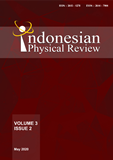ANALISA KURVA PDD DAN PROFILE DOSE BERKAS ELEKTRON PESAWAT LINAC VARIAN CLINAC CX
DOI:
10.29303/ipr.v3i2.43Downloads
Abstract
Linac (linear Accelerator) is a radiotherapy device that utilizes radiation to kill cancer cells. Every radioterap equipment such as Linac aircraft must be calibrated periodically. One of them is monthly quality control which aims to test the performance of Linac so that the quality of the output of the radiation beam can be guaranteed. Quality control conducted is the measurement of Percentage Depth Dose (PDD) and Profile Dose. In PDD measurements, the Linac Variant Clinac CX electron beam (4, 6, 9, 12, and 15) MeV planes are used with a radiation field of 15 × 15 cm2. While the profile dose is measured in the radiation field 10 × 10 cm2 and 25 × 25 cm2 and using blue phantom, (referenc and field) detectors are equipped with computer control units (CCU) and carried out for crossline and inline directions at Dmax depth and certain depth with SSD 100 cm. The measurement results show the greater the electron energy used, the maximum dose (Dmax) obtained is getting smaller, conversely the greater the electron energy used, the greater the depth for the maximum dose. And the measurement results still meet the tolerance measurement that is ± 0.2. While the results of the Dose Profile measurements show a field area of 25 × 25 cm2 more flatness and symmetry than a 10 × 10 cm2 field area both inline and crosline directions and still meet measurement tolerances of ± 4.5% - ± 7% for flatness and ± 2 % for symmetry.
License
Authors who publish with Indonesian Physical Review Journal, agree to the following terms:
- Authors retain copyright and grant the journal right of first publication with the work simultaneously licensed under a Creative Commons Attribution-ShareAlike 4.0 International Licence (CC BY SA-4.0). This license allows authors to use all articles, data sets, graphics, and appendices in data mining applications, search engines, web sites, blogs, and other platforms by providing an appropriate reference. The journal allows the author(s) to hold the copyright without restrictions and will retain publishing rights without restrictions.
- Authors are able to enter into separate, additional contractual arrangements for the non-exclusive distribution of the journal's published version of the work (e.g., post it to an institutional repository or publish it in a book), with an acknowledgment of its initial publication in Indonesian Physical Review Journal.
- Authors are permitted and encouraged to post their work online (e.g., in institutional repositories or on their website) prior to and during the submission process, as it can lead to productive exchanges, as well as earlier and greater citation of published work (See The Effect of Open Access).





